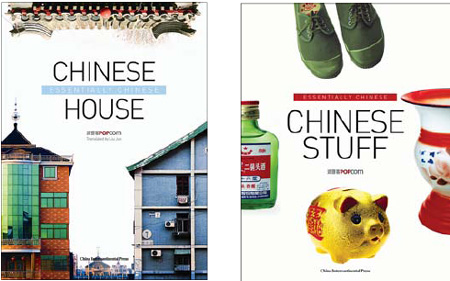
Why do most Chinese families use hot-water thermoses painted with peony flowers? What can you do with a long bamboo stick, which has one end shaped like a small hand?
Why does a luxurious housing estate in Beijing have a grand front gate, modeled on Berlin's Brandenburg Gate, but contain modern-style buildings? Why would anyone want to live in miniature European castles that also have four upturned eaves, the type seen in Chinese temples?
For any curious visitor who asks these questions, "Chinese Stuff" and "Chinese Houses", published recently by the China Intercontinental Press offers the answers.
Compiled by Popcorn, a small creative team headed by Professor Wu Xuefu with the Communications University of China, the two books in both Chinese and English are part of a series that aim at raising awareness about the "Chinese element". Majoring in art and advertising, Wu is fascinated by details of everyday life that he says "shed light on the unique aesthetic views of modern Chinese".
The thermos bottle, for instance, is not just a utensil that contains hot water Chinese people love so much. The huge blossoming red peony flowers on its cover also display the nation's obsession with auspicious symbols. The peony represents good fortune and high official ranking.
A pair of mandarin ducks (yuanyang) can always be found on the quilt cover given to the bride by her mother, which is a wish that the newly weds will live together happily ever after.
As for the bamboo stick, it is nicknamed "ask no one for help" (bu qiu ren), because you can easily scratch your own back when it itches.
Such interesting little things found in a common Chinese household provide glimpses of a particular focus Chinese have regarding a quality of life.
When entering a modern Chinese office, one might be puzzled at the crimson banner on the wall featuring golden characters.
It is a common way of expressing gratitude and many different set phrases are passed down through generations to suit different occasions.
Wu says this is a classic case of the social-political tradition becoming "habitual" and producing items which are closely intertwined in daily life.
Compared with "Chinese Stuff," "Chinese Houses" is weightier, though it carries plentiful illustrations with humorous captions.
Wu argues that the most striking feature of contemporary houses where ordinary Chinese live and work is "mixed" - "mixed styles in general and playful concoction of symbols and codes". He says that Chinese houses often display a total negligence of architectural aesthetics in their excessive decorations, which blindly duplicate ancient Chinese styles or Western concepts.
There is an obsession with the fengshui metaphors while the traditional value of harmony between man and nature is neglected.
As the Chinese economy gains increasing weight in the world, the nation is going through huge waves of deconstruction and construction unseen in centuries.
When people are in such a hurry, they don't care much about creating architecture that can stand the test of time.
While ancient Chinese paid great attention to the harmony between man and nature, most Chinese houses today show no concern for this comfort index and the aesthetic surroundings.
For example, throughout the year mops might be left outside the front gate of an important building. Residents of a high-end community might tolerate piles of sand left untouched outside the wall for years.
Unlike prominent architecture, most Chinese houses are influenced by a psychology rooted in an agricultural civilization, which has reigned for millennia.
"If we say that architecture is a mirror of its time, we believe that this is a unique historical period full of houses with mixed styles," Wu says.
(China Daily June 30, 2009)